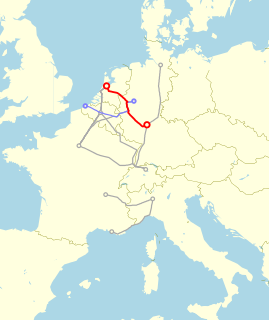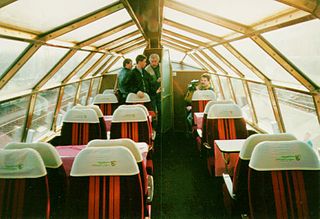| Overview | |
|---|---|
| Service type | Trans Europ Express (TEE) (1979–1980) InterCity (IC) (1985–1991) (1994–1998) |
| Status | Discontinued |
| Locale | Germany |
| First service | 28 May 1979 |
| Last service | 23 May 1998 |
| Former operator(s) | Deutsche Bundesbahn / Deutsche Bahn |
| Route | |
| Service frequency | Weekdays |
| Technical | |
| Track gauge | 1,435 mm (4 ft 8+1⁄2 in) |
| Electrification | 15 kV 16.7 Hz |
The Bacchus was an express train in Germany, initially linking Dortmund and Munich. The train was named after the Roman God of wine, although for most of its existence it linked two cities famous for producing beer. [1]
In 1971 the Deutsche Bundesbahn started an inner German network of first-class only InterCity services modeled after the Trans Europ Express (TEE) criteria, but more frequent than the TEE, one train per hour instead of one train a day. During the 1970s the introduction of second-class coaches in the Intercities was proposed and tested on some routes, resulting in the IC79 project. [2]
The IC79 project was implemented at 28 May 1979, but seven inner German services, including a new train, the Bacchus, stayed first-class-only and were classed as TEE to distinguish them from the two-class InterCity. [3]
The TEE Bacchus was withdrawn only one year after the introduction. As it had run only on weekdays, Bacchus earned itself a record as the shortest-lived TEE, with 254 days of service. [4]
The Bacchus was revived as two class InterCity on 2 June 1985 on the same route until 1 June 1991. A third Bacchus ran between Stuttgart and Münster from 29 May 1994 until 23 May 1998. [5]

The trainsets of Class VT 11.5 were diesel multiple units built by Deutsche Bundesbahn (DB) in 1957 and used for Trans Europ Express (TEE) services. Perceived as flagships of the DB rolling stock, they carried first-class seating only. When the UIC numbering scheme became effective on 1 January 1968, the power heads of the trainsets were renamed to Class 601 whilst the middle cars became Class 901 according to the DB locomotive classification. They were used for TEE service from 1957 until 1972 and thereafter on German InterCity services.

The DB Class 403 was a series of three electric multiple units commissioned by the Deutsche Bundesbahn in the 1970s, an early predecessor of the Intercity-Express as a high-speed train. The units were mainly used for InterCity services and again by the Lufthansa airline in the 1980s. Due to the distinctive design of its front section, the unit was nicknamed the "Donald Duck". They were designed for operational speeds of up to 220 km/h, a speed which was also attained in extensive test drives, but they were limited to 200 km/h in regular DB service.

The Blauer Enzian is a named express train service that currently runs between Frankfurt in Germany and Klagenfurt in Austria. Introduced in 1951, it originally ran via the German North–South railway line between Hamburg and Munich. Labelled as an international Trans Europ Express (TEE) train, it also linked with Zell am See and Klagenfurt in Austria from 1969. Trains were operated by the Deutsche Bundesbahn (DB) and its Deutsche Bahn successor, from 1970 also by the Austrian Federal Railways (ÖBB).
The Diamant was an express train operated by the Deutsche Bundesbahn (DB), using different routes over the years. The name Diamant, Dutch for diamond, refers to the city of Antwerp, which is the European centre of diamond trade and has a diamond district. The initial service started in 1962 as a first-class-only FernTriebwagen linking the West-German capital Bonn with Antwerp, using a class DB Class VT 08 diesel multiple unit (DMU).

The Merkur was an international express train linking Copenhagen, the Danish capital, with Germany. The train was named after the Roman God Mercury, the God of traders and travellers.
The Lemano was an international express train linking Milan with Geneva. The train is named after Lake Geneva, the north shore of which was followed by the train over the lake's entire length. Introduced in 1958, it was a first-class-only Trans Europ Express service until 1982, and thereafter a two-class express train.

The Rhein–Main was an express train that linked Frankfurt am Main with Dortmund in Germany and later with Amsterdam in the Netherlands. The train was named after the two rivers, the Rhine and the Main, that join west of Frankfurt. For most of its life, it was a Trans Europ Express (TEE).

The Paris–Ruhr was an express train that linked Paris in France, with Dortmund in Germany. The train was named after its two termini, Paris in the west and the Ruhr district in the east. For most of its life, it was a Trans Europ Express (TEE).

The Rembrandt was an express train that linked Amsterdam in the Netherlands, with Munich in Germany and later Chur in Switzerland. The train was named after the renowned Dutch painter Rembrandt. For its first 16 years it was a first-class-only Trans Europ Express, becoming a two-class InterCity in 1983 and finally a EuroCity in 1987.

The Parsifal was an express train that linked Paris with Dortmund in Germany and later Cologne. The train was named after Wagner's opera inspired by the legendary knight Percival.

The Erasmus was an express train that linked The Hague, the Dutch seat of Government, with Munich in Germany. The train was named after the Dutch Renaissance humanist Desiderius Erasmus.
The Friedrich Schiller was an express train in Germany, initially linking Düsseldorf and Stuttgart. The train was named after the philosopher and playwright Friedrich Schiller.

The Lufthansa Airport Express was an express train service in Germany, initially linking Düsseldorf and Frankfurt am Main Flughafen, and later Stuttgart too. The trains were operated by Deutsche Bundesbahn on behalf of the German airline Lufthansa, and with the airline providing the on-board customer service staff, and its use was limited to Lufthansa customers taking airplane flights into or out of Frankfurt or Düsseldorf airports.

The Gambrinus was an express train in Germany, initially linking Munich and Kiel. The train was named after the God of Beer Gambrinus.
The Heinrich Heine was an express train operated by Deutsche Bundesbahn, initially linking Frankfurt am Main and Dortmund. The train was named after the German poet and journalist Heinrich Heine.

The Adriatico was an express train operated by Ferrovie dello Stato, linking Milan and Bari. It was named for the Adriatic Sea, Mare Adriatico in Italian, as the train's route served the main cities along the shore of the Adriatic between Rimini and Bari.
The Cycnus was an express train operated by Ferrovie dello Stato, linking Milan with Ventimiglia, Italy. Cycnus literally means swan, but more likely the name refers to the mythological King of Liguria, the region the train served.

The Molière was an international train operated by SNCF, initially linking Paris and Düsseldorf. The train was named after Jean Baptiste Poquelin, using his stage name.

The Van Beethoven was an international train linking the Dutch capital Amsterdam and the West German capital Bonn. The train was named after the Bonn-born composer Ludwig van Beethoven.

The Colosseum was an express train initially linking Rome and Milan, later Frankfurt am Main. The train was named after the Amphitheatrum Flavium, renowned as the Colosseum.